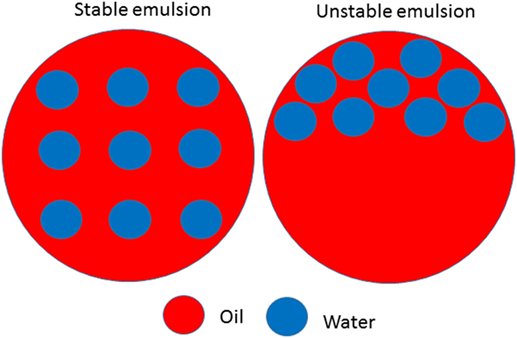

There are many examples of emulsions in our daily life. To name a few, they are mayonnaise, milk, salad dressings, hand lotion, and hair conditioners. The lowered surface energy might also mean that the emulsion creates more wetting, which might not always be wanted. It is emulsified with the aqueous phase, containing an emulsifier in a high shear mixer, which is followed by addition of water to induce the diffusion of organic solvent, resulting in formation of nanoparticles. For cases in which it is (cosmetically) needed/wanted to have a perfectly clear liquid, it can be difficult to achieve this with enough emulsifier in the mixture. An oil/water (o/w) emulsion is prepared with oil phase, containing polymer (and drug) and an organic solvent. Downside of emulsionsĪn emulsion has the property that it lowers the surface tension of the water and often turns it slightly cloudy. The optimum processing conditions for preparing W/O/W emulsions are as follows: the ratio of the oil phase to the internal water phase is 80 : 20, the concentrations of lipophilic and hydrophilic emulsifiers are 10 wt and 5 wt, and the homogeneous pressures in the first and second steps are 30 MPa and 10 MPa. QD’s carry a mixture that is similar to paste wax, but thinner and with less wax-like ingredients. This basis makes it very easy to dilute the QD, and thus making it easier to create a concentrated version of the product, which is more economical and favorable for the customer. Many QD’s are emulsion of wax, oils and a water-like carrier.

The emulsifier in the soap will make it possible for the water molecules to cling to the oil molecules, creating an emulsion of grease and water.Īnother popular formulation for an emulsion is a quick detailer. Soap turns water with a high surface tension into a solution with a very low surface tension, making it capable to interact will hydrophobic molecules. This means that the water has to be capable of mixing with the water, otherwise it will still be very difficult to remove. When you want to wash your dishes, you need to remove oil and other grim from the plates and pans. When do you need an emulsionĪn emulsion can be usefull for several reasons. In a water-in-oil emulsion, the roles are switched.
An example of an oil in water emulsion is skin#
The first two examples are not natural formulations (they contain mineral oil) whereas Weleda’s iconic Skin Food is a natural formulation. When an emulsion is oil-in-water, oil is the dispersed phase that is distributed into the continuous phase, water. This creates 2 different molecules, sticking together thanks to the emlusifier. Examples of W/O emulsions on the market To give you a better sense of what a water-in-oil emulsion is like, let’s look at some classic examples. The hydrophobic head will stick to the oil, the hydrophilic tail will stick to the water. This gives it the capacity to cling to the oil molecule and also with the water molecule. Surfactants play an important role in their manufacture and their subsequent. In milk, the fat globules (act as the dispersed phase) are suspended in water (act as the dispersion medium). Milk is an example of an oil-in-water emulsion with relatively low levels of oil. An emulsion is another substance that is both hydrophobic and hydrophilic. The milk is an example of the oil in water (o/w) type of emulsion. When oil molecules come into contact with water molecules, the molecules will not mix with each other. The amount of chemical is based on the total amount of emulsion (oil and water). The required dosage of the chemical is added to the centrifuge tubes. The centrifuge tubes are placed in a water bath for a minimum of 30 minutes to reach the desired temperature. In an oil-in-water (o/w) emulsions, the dispersed phase (discontinuous or internal phase) phase is oil, and the dispersion medium (continuous or external phase). Oils are naturally hydrophobic, meaning they act as if they repell water. The mixed emulsion sample is added to 100-ml standard centrifuge tubes. The mixture you end up with is reffered to as an emulsion. If you want to combine these you will need something that holds them together. Here’s what I didn’t understand: to successfully emulsify anything, you need to slowly add the oil in a thin, but steady, stream. We carry hundreds of active ingredients (cosmeceuticals) with different properties and functions for making all kinds of effective, bioactive skin and hair care products.In some cases, oil has certain characteristics that you want to use, but water also has some useful properties.


 0 kommentar(er)
0 kommentar(er)
